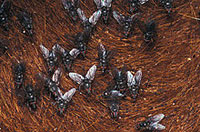BASTROP – External parasites can be costly for cattle producers and getting a handle on problems early can lead to more prosperous and better performing cows.
Dr. Jason Cleere, Texas A&M AgriLife Extension Service beef cattle specialist, College Station told producers at the Independent Cattlemen’s Association meeting in Bastrop examples of external parasites are bloodsucking flies, which include the horn fly, stable fly, horse fly and deer fly.

“Sometimes you will see cattle just run across the pasture. They are using up energy,” he said. “Ultimately, it leads to reduced profitability.”
For ranchers, first they must identify the external parasite.
“How big of an external parasite problem do you have?” he asked. “Does it have economic implications? What method or methods can I use to control them?”
Activity varies among the different flies. Cleere said while the horn flies rest on the back of the cows, stable flies remain on the cow only while feeding and feed mainly on the legs.
“The horn fly is our most damaging because they do suck blood and reduce the performance of the cow,” Cleere said. “Adult flies live for about three weeks and feed up to 30 times a day.”
They lay eggs profusely, especially around manure piles. Within nine to 12 days reproduction can occur, he said.
“When we see a big flush of flies come in, there is usually moderate temperatures and recent moisture,” he said.
Peak populations for horn fly are late spring and early fall. He said the economic treatment level is approximately 250 flies per animal. Treatments include pour-on, sprays, ear tags, feed additives, dusts and rubs.
Cleere said when it comes to fly control, there are biological controls such as parasitic wasps. Cultural remedies can include removing fresh manure from barns and stalls and preventing buildup of wet, decomposing vegetation such as hay.
“Keep your barns clean and manure away,” he said. “That’s going to be your biggest ally in controlling flies in those areas. Keep things clean and sanitary.”
Biological control includes parasitic wasps, which are fly predators, and are effective but not viable on a large commercial cattle production scale since there are large numbers of animals in a herd. Chemical horn fly control includes ear tags, pour-ons, sprays, feed additives, boluses, dust bags, rubs and gel caps.
Pyrethoids, organophosphates, organochlorine and abamectin are some topical products. Oral products are IGR (insect growth regulator) and organophosphates.
“Producers deworming using a pour-on are getting a knock down in fly populations for about 30 days,” Cleere said.
The challenge with rubs is getting the cattle to use them, Cleere said.
“If you have some areas where cattle are traveling back and forth, it’s certainly a valid option.”
Ear tags require putting the cattle in a chute. They provide about 90 to 150 days of control and fly season typically lasts longer. The challenge with pour-ons is labor of working and applying the pour-ons and a time-frame of 20 to 30 days, Cleere said.
Feed additives in mineral supplements costs about $4.50 to $8 per head a year if the cow is eating a bag of mineral a year, he said.